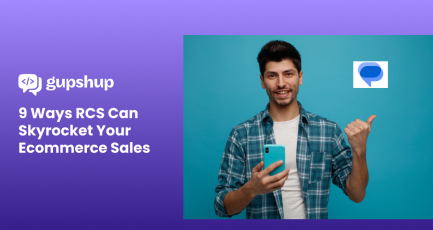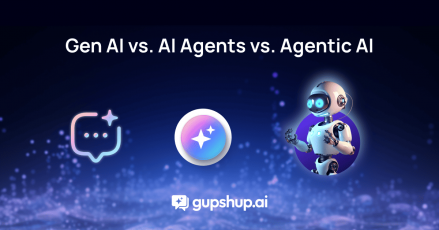What is Conversational Advertising? An Introductory Guide

Introduction
As more businesses are adopting digital technologies, creative video ads and flashy banners are no longer sufficient. Personalization has become essential for brands aiming to stand out and boost sales. Consumers now demand personalized and conversational marketing. McKinsey reports that 71% of consumers expect personalized interactions, and 76% are frustrated when this expectation is not met. Companies that excel in personalization can see 40% higher revenue from these activities compared to average competitors.
In this context, conversational advertising, backed by conversational AI, is the game-changer, revolutionizing how businesses engage with their customers.
This form of marketing fosters two-way interactions, making customer engagement more personalized and convenient. Platforms like Facebook, WhatsApp, and Instagram, enhanced by Click-to-Chat advertisements, play a pivotal role in this shift. Conversations initiated through these channels, supported by chatbots and virtual assistants, are key to effective personalization.
Now, how does conversational advertising transform personalized marketing? Let’s explore!

What is Conversational Advertising?
Conversational advertising is a digital marketing strategy that incorporates two-way communication between consumers and brands. These advertisements evoke customers’ interest and prompt them to engage with brands where they promote their products and services. The conversations have a personal, human-like touch, keeping the customers engaged and interested, thereby driving conversion.
Let us now have a look at how conversational advertising works.
How Does Conversational Advertising Work?
Using communication elements and making the advertisement interactive is a great way to facilitate communication between customers and brands, which might evoke the customer’s interest. Two-way communication ensures potential customers can share their interests, queries, thoughts, and preferences directly with the brand.
This provides potential customers with accurate information about the products/services they might be interested in and helps the brand gather valuable insights about the customer’s choice, thereby creating a win-win situation for both. Brands can also use the data thus gathered to send potential customers personalized marketing campaigns that might interest them.
Businesses can display personalized ads on a customer’s social media feed, and add CTAs that can redirect the customers to the business’ WhatsApp chat, thereby facilitating communication. According to Statista, the click-through rate of social media ads have gone up from 0.92% in the third quarter of 2023 to 0.98% in the fourth quarter of 2023.
Conversational ads allow brands to engage users in real-time, making conversations more memorable and likely to lead to interaction with the brand.
This approach is an efficient and cost-effective way to reach target audiences and drive conversions. These ads also save customers the hassle of having to fill out web forms stating their preferences and waiting for the businesses to revert back. It also prevents customers from changing their minds about the brand and dropping off.
Why Do Businesses Need Conversational Advertisements?

Considering the current market trends and the preferences of the customers, it has become essential for businesses to embrace conversational advertising. Here’s why:
1. To understand customer preferences
Customers nowadays take complex and unpredictable paths, using various resources and options. Statista shows that 64% of shoppers check online reviews before buying. They might start on social media, visit websites, read reviews, watch videos, and explore different touchpoints, often distracted by external factors like changing preferences or new information.
This makes capturing and maintaining customer interest challenging. Conversational advertisements address this by displaying ads across social media with a link or CTA button, leading customers to an omnichannel conversation page.
2. To Ensure Data Security
Incorporating the use of third-parties for data collection may expose the data shared by customers to the risk of being breached. As businesses are putting emphasis on privacy regulations, AI-based conversational chatbots are becoming more important.
These chatbots are a great way for businesses to interact directly with customers and gather data firsthand. The use of LLMs also helps in understanding user sentiment and curating personalized messages for each customer, thereby making it easier to drive conversions.
3. To overcome the limitations of conventional chatbots
Conventional chatbots on ad landing pages use pre-recorded responses and lack personalization, making interactions irrelevant and scripted. Conversational advertisements enhance customer engagement with AI-driven chatbots and live chat tools. These technologies understand customer sentiment and preferences, providing tailored responses.
This personalization improves business efficiency by better understanding conversation context, increasing natural flow, and reducing disruptions, which leads to higher conversions and revenue.
Businesses can support conversational marketing at every stage of a customer’s purchase journey. Let’s see how further.
Redirect Your Customers from Facebook and Instagram to Your WhatsApp Landing Page

The global number of social media users is approximately 5.07 billion. What once was a great place for socializing is now an essential platform for businesses to support their objectives, such as lead generation, sales, and marketing.
People spend considerable amounts of time scrolling through their Facebook and Instagram feeds. These social media sites serve as great entry points for businesses (a.k.a. the multiple touchpoints for your customer to enter your marketing funnel).
As discussed before, businesses can display advertisements to customers along with a CTA button or link, which can land customers on the business’ WhatsApp — leveraging WhatsApp as the new landing page. This ensures a smooth transition without the customer having to switch between different apps or websites.
Now, how do we use conversational advertising to offer personalized marketing at each stage?
1. Pre-purchase stage
In the pre-purchase phase, conversational advertising helps businesses introduce a product or service to the customers.
Businesses can evoke the interest of customers through a catchy advertisement, and incorporate the use of “Click-to-WhatsApp” feature, that can land the customers to the business’ WhatsApp chat box. This way, businesses and customers can engage in direct communication with one another. It is also helpful for consultation, as customers can ask the virtual chat assistant countless questions and have them all answered.
It is in this stage of the purchase journey itself that customers decide whether they should stick with a brand. In doing so, personalization plays an important role.
Nowadays, customers prefer to opt for brands that can gauge their attention quickly and offer them a personalized experience. They want to be treated as individuals. Therefore, brands that suggest products that align with the customers’ interests and give tailored responses are much sought after by customers.
Let’s understand this situation with an example. Let’s assume a customer had initially purchased cakes and gifts from a confectionery brand that customizes orders based on customers’ requests.
The brand can send a reminder message to Duke on the same day, next year, sending recommendations.
Notice the extent of personalization in this conversation. The brand keeps track of all the orders in its database and incorporates AI and ML algorithms to derive the sentiment behind each order. This kind of personalization makes the customer feel extremely valued.
The effect of personalization and the importance of delivering optimum customer experience is becoming so important these days that global revenue for the personalization and optimization software and services industry is likely to increase from 7.6 billion USD in 2021 to 11.6 billion USD in 2026.
Therefore, businesses that excel in delivering personalized conversational marketing experiences are more likely to thrive amidst cut-throat competition, win loyal customers, and generate good ROI.
2. Purchase stage
The more convincing the conversation between the customer and the business, the better the chances of conversion.
A good conversational AI chatbot can elevate customers’ shopping experiences by transforming the WhatsApp chatbot into a virtual showroom. WhatsApp has exclusive features, like catalog templates, that help businesses display their product catalog entirely within a WhatsApp chat. These catalog templates showcase a product thumbnail, a header image, a customer body text, a fixed text header, and a fixed text subheader.
For instance, Housing.com incorporated Gupshup’s conversational AI services to simplify property listings, and witnessed 1.8 times more conversions.
After a customer has chosen a product and has gathered adequate information about it, the business’ WhatsApp chatbot may send messages like, “Click here to add this item to your cart” or “Click here to make your payment of xxx INR.” This ensures a smooth conversion process, thereby prompting sales.
This also helps avert diversions on the end of the customer by preventing him from switching to a different window for adding a product to a cart or completing a payment. Even if a customer is distracted by chance, a business sends a gentle reminder.
This not only prompts Sarah to complete the purchase but also removes friction at the checkout points, thereby making it easier to drive conversions.
Even if you sense your customer is looking forward to buying a product that might currently be out of stock, you can send a conversational advertising message as soon as the product is back in stock, stating, “Heya, mate! Your favorite PQR cutlery set is back in stock.”.
3. Post-purchase stage
A good brand makes sure that customers do not feel undervalued after the purchase has been completed. Suppose a customer has bought an electronic gadget from your brand. In that case, the customer should not have to chase you around to schedule an appointment with your executives for installation and demonstration. It should be the other way around.
A WhatsApp chatbot can streamline the customer experience. Let us see a chat template in support of this instance:

This kind of conversational support helps build the customers’ trust and establishes a sense of loyalty towards the brand.
Conclusion
Conversational advertising is the future. Spare your customers the hassle of reading lengthy product descriptions and add the sweet element of personalization to seal the deals.
Conversational AI and virtual chat assistants revolutionize how businesses interact with customers by enabling real-time, two-way communication. This innovation not only drives conversions but also significantly boosts customer satisfaction.
Gupshup, a leader in conversational AI, offers cutting-edge AI solutions that transform customer interactions. Whether personalized product recommendations or seamless checkout processes, Gupshup ensures your customers have a smooth, enjoyable journey.
Transform your marketing strategies today! Pair up today.
FAQ’s
1. How effective do you think using WhatsApp as part of your mobile marketing campaign?
WhatsApp has around 2 billion users globally. Therefore, businesses that use WhatsApp for mobile marketing can reach a wide range of customers at once. However, it is important to leverage conversational AI capabilities correctly to send personalized messages and offers to the right target audiences.
2. Are personalized ads effective?
Personalized ads are beneficial for both businesses and customers. They have a higher click-through rate, thereby reducing wasted ad spend. On the other hand, customers can also make decisions by viewing fewer ads directed toward them and aligning them with their interests.
3. Why is post-purchase support important?
Brands offering good post-purchase support can build a stronger reputation, prompting customers to repeat purchases.




